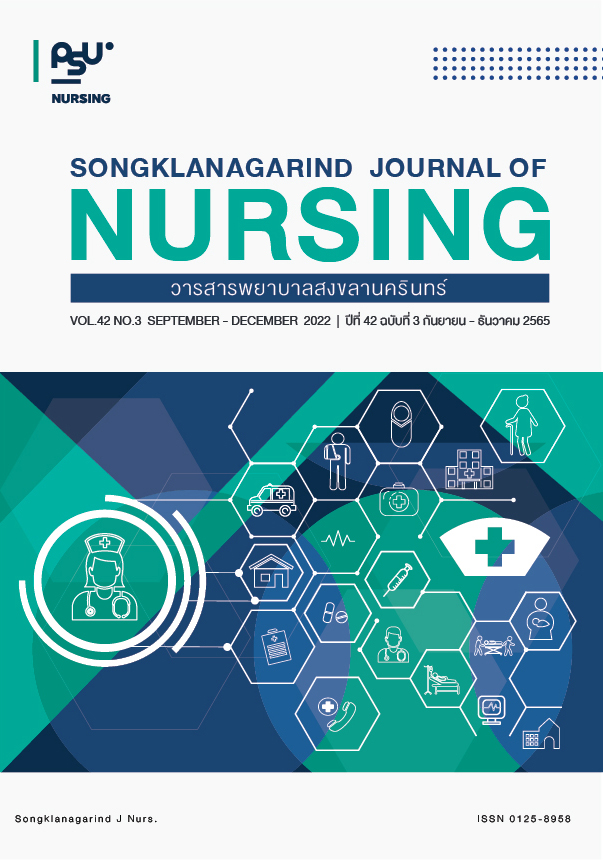Transitional Care for Older Adult Patients Receiving High Flow Nasal Cannula Therapy: in Hospitalization
Main Article Content
Abstract
Introduction: The Naylor transitional care approach could be applied in caring for older patients with hypoxia who need high-flow nasal cannula (HFNC) therapy during the transitional period. This approach entails: 1) comprehensive screening including physical problems, respiratory function and other related organs, function decline, activity of daily living, cognitive function, geriatric syndromes, comorbidities, polypharmacy, and psychological aspects such as anxiety and fear; 2) effective communication of evidencebased practices of HFNC therapy; 3) coordination of multidisciplinary self-care practices and rehabilitation
of the respiratory system and related functions; 4) engagement among patients, family caregivers, and the
healthcare team; and 5) continuity of care through home visits. Conclusions: The HFNC transitional care for hospitalized older individuals focuses on comprehensive health assessment, implementation of evidence-based nursing practices, cooperation between patients, caregivers, and the healthcare team, and efficient continuity of care.
Article Details

This work is licensed under a Creative Commons Attribution-NonCommercial-NoDerivatives 4.0 International License.
References
Ricard JD, Roca O, Lemiale V, et al. Use of nasal high flow oxygen during acute respiratory failure. Intensive Care Med. 2020; 46(12): 2238-47. doi: 10.1007/s00134-020-06228-7.
Helviz Y, Einav S. A Systematic review of the high-flow nasal cannula for adult patients. Crit Care. 2018; 22(1): 71. doi: 10.1186/s13054-018-1990-4.
Parke R, McGuinness S, Eccleston M. Nasal high-flow therapy delivers low level positive airway pressure. Br J Anaesth. 2009; 103(6): 886-90. doi: 10.1093/bja/aep280.
Wangsom A. Wattanachai T. Nursing care of pneumonia patients with acute respiratory failure receiving high-flow nasal cannula therapy: A study of 2 cases. Mahasarakham Hospital Journal. 2021; 18(2): 123-32. Thai.
Mauri T, Turrini C, Eronia N, et al. Physiologic effects of high-flow nasal cannula in acute hypoxemic respiratory failure. Am J Respir Crit Care Med. 2017; 195(9): 1207-15. doi: 10.1164/rccm.201605-0916OC.
Lee CC, Mankodi D, Shaharyar S, et al. High flow nasal cannula versus conventional oxygen therapy and noninvasive ventilation in adults with acute hypoxemic respiratory failure: A systematic review. Respir Med. 2016; 121: 100-8. doi: 10.1016/j.rmed.2016.11.004.
Naylor MD. Transitional care: A critical dimension of the home healthcare quality agenda. J Healthc Qual. 2006; 28(1): 48-54. doi: 10.1111/j.1945-1474.2006.tb00594.x.
Naylor MD. Transitional care for older adults: A costeffective model. LDI Issue Brief. 2004; 9(6): 1-4. PMID: 15181894.
Naylor MD, Toles M. The challenge of providing evidencebased transitional care. Investig Enferm Imagen Desarr. 2021; 23: Editorial. doi: 10.11144/Javeriana.ie23.cpet.
Naylor MD, Brooten DA, Campbell RL, et al. Transitional care of older adults hospitalized with heart failure: A randomized, controlled trial. J Am Geriatr Soc. 2004; 52(5): 675-84. doi: 10.1111/j.1532-5415.2004.52202.x.
Hirschman KB, Shaid E, McCauley K, et al. Continuity of care: The transitional care model. Online J Issues Nurs. 2015; 20(3): 1. PMID: 26882510.
Morkisch N, Upegui-Arango LD, Cardona MI, et al. Components of the transitional care model (TCM) to reduce readmission in geriatric patients: A systematic review. BMC Geriatr. 2020; 20(1): 345. doi: 10.1186/s12877-020-01747-w.
Demir Avci Y, Gözüm S. Effect of transitional care modelbased interventions for patients with stroke and their caregivers on increasing caregiver competence and patient outcomes: A study protocol for a randomized controlled trial. Florence Nightingale J Nurs. 2021; 29(2): 176-85. doi: 10.5152/FNJN.2021.19214.
Naylor MD, Shaid EC, Carpenter D, et al. Components of comprehensive and effective transitional care. J Am Geriatr Soc. 2017; 65(6): 1119-25. doi: 10.1111/jgs.14782.
Naylor MD, Hirschman KB, Toles MP, et al. Adaptations of the evidence-based transitional care model in the US. Soc Sci Med. 2018; 213: 28-36. doi: 10.1016/j.socscimed.2018.07.023.
Jo HS, Jeong S, Kim WJ, et al. Development of a transitional care model program for patients with pneumonia, asthma, and chronic obstructive pulmonary disease: In-depth interviews with readmitted patients. J Korean Med Sci. 2020; 35(42): e352. doi: 10.3346/jkms.2020.35.e352.
Naylor MD, Hirschman KB, McCauley K, et al. MIRRORTCM: Multisite replication of a randomized controlled trial-Transitional Care Model. Contemp Clin Trials. 2022; 112: 106620. doi: 10.1016/j.cct.2021.106620.
Ortiz MR. Transitional care: Nursing knowledge and policy implications. Nurs Sci Q. 2019; 32(1): 73-7. doi: 10.1177/0894318418807938.
Thaniwattananon P. Care towards best nursing practice in geriatric syndromes. 1 st ed. Songkhla: Chanmuang Press; 2016. Thai.
Drake MG. High-flow nasal cannula oxygen in adults: An evidence-based assessment. Ann Am Thorac Soc. 2018; 15(2): 145-55. doi: 10.1513/AnnalsATS.201707-548FR.
Portolés J, Martín L, Broseta JJ, et al. Anemia in chronic kidney disease: From pathophysiology and current treatments, to future agents. Front Med (Lausanne). 2021; 26(8): 642296. doi: 10.3389/fmed.2021.642296.
Roca O, Messika J, Caralt B, et al. Predicting success of high-flow nasal cannula in pneumonia patients with hypoxemic respiratory failure: The utility of the ROX index. J Crit Care. 2016; 35: 200-5. doi: 10.1016/j.jcrc.2016.05.022.016.05.022.
Pichitpornchai W. Asdornwised U. Discharge planning: Concept and application. 2nd ed. Bangkok: Faculty of Nursing, Mahidol University; 2003. Thai.


